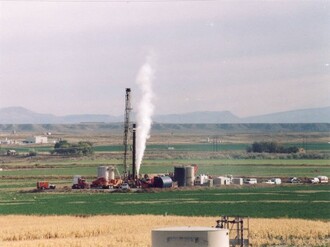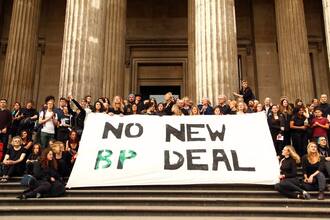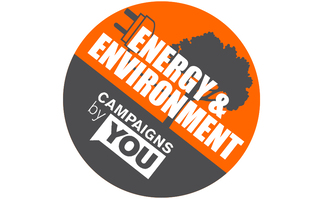-
A moratorium is not a ban. Ban fracking in Wales.The scientific evidence of the risks and harms of unconventional gas development mounts every year and we believe that fracked gas has no place in Wales's low carbon future. The 2015 Paris climate agreement, the Well-being of Future Generations (Wales) Act of 2015 and the Environment (Wales) Act of 2016 all make it clear that a swift transition to renewable energy is needed. This is the direction that Wales should firmly take.412 of 500 SignaturesCreated by Donal Whelan
-
Energise Wales - move to 100% renewable energy in 20 yearsThe 2015 Paris climate agreement, the Well-being of Future Generations (Wales) Act of 2015 and the Environment (Wales) Act of 2016 make our moral and legal obligations clear - in the face of potentially catastrophic climate change, we must act now to protect future generations. This transition is totally feasible, both technically and financially, and such a bold programme could be transformative for Wales. It would attract green investment, create tens of thousands of jobs and give Wales ownership of its own energy generation and distribution systems. This would be true energy security and it would give Wales political and economic freedom like never before in its history. ------ Mae Cytundeb Hinsawdd Paris 2015, Deddf Llesiant Cenhedlaethau'r Dyfodol (Cymru) 2015 a Deddf Amgylchedd (Cymru) 2016 yn glir iawn ei ddisgwyliadau moesol a chyfreithiol - yng ngwyneb newid hinsawdd a allai fod yn gatastroffig, rhaid i ni weithredu yn awr i amddiffyn cenedlaethau'r dyfodol. Mae'r trawsnewidiad hwn yn gwbl oddifewn ein gallu, yn dechnegol ac yn ariannol, ac fe allai rhaglen uchelgeisiol o'r math fod yn drawsffurfiol i Gymru. Fe fyddai'n denu buddsoddiad gwyrdd, creu degau o filoedd o swyddi a rhoi i Gymru berchnogaeth ar ei systemau ei hunan o gynhyrchu a dosbarthu ynni. Byddai hyn yn wir sicrwydd-ynni ac yn rhoi i Gymru ryddid economaidd a gwleidyddol na fu ganddi erioed o'r blaen.673 of 800 SignaturesCreated by Donal Whelan
-
Demand the Environment Agency properly monitors the air and water around UFF sites!Unconventional Fossil Fuels extraction and the Volatile Organic Compounds that are released as gasses and liquid spills are inherently dangerous, and we have plenty of evidence from other countries that it causes major damage to life and health. If this industry is to be allowed to operate in this country close to people they should be regulated and monitored stringently. If the cost has to come from the industry then so be it, we need to ensure that the public, animals and environment are safe, and so far with calls to the sites that have been active in the UK the response from the EA has been less than desirable; lying and failing in their duties. Millions of lives are at risk if these wells leak, we need to prevent this from happening. At this moment in time there is no public safety net from this industry who are releasing contaminants into the atmosphere.150 of 200 SignaturesCreated by Danny Llew
-
Cancel the Hinkley Point C nuclear reactor projectHinkley Point C is a vastly expensive project which has a good chance of failing, at great cost to UK electricity consumers. The model of reactor chosen for Hinkley Point C, the EPR (European Pressurised Reactor), is proving to be a technical disaster. Four are under construction in Finland, France and China and all overdue and over cost - the one in Finland is 9 years behind schedule. The cost of the Hinkley programme has escalated to £18billion and is likely to rise further. At present, the UK demand for electricity is falling and the cost of energy on world markets is also falling. Renewable technologies such as solar and wind are also rapidly becoming cheaper and represent far better value for money if we wish to invest in low-carbon electricity production. The Hinkley reactors will be funded by EDF, a company largely owned by the French government. Its finance director has resigned as he believes the company cannot afford the project. In order to attract investment in the project from France and China, the UK government has guaranteed a unit price for the power produced which is roughly three times the current price. This will inflate the electricity bills of all consumers for decades to come. Since it is a Government decision, it is effectively a tax which we can in no way avoid. A government which professes to believe in the free market has rigged the market by promising the French and Chinese investors a large return on their investment. Any profits will leave the country. Hinkley Point C is an infrastructure project that will end up as a white elephant. The next generation will not understand why we allowed such a grandiose project to be built. They will be left to pay the price through inflated electricity bills and to deal with the nuclear waste which the reactors will produce.412 of 500 SignaturesCreated by David Sang
-
PROTECT THE NORTHEAST COASTLINEWith Five Quarters nolonger in operation there is only Cluff Natural Resources with licences who want use the North East as a testbed for undersea coal gasification (UCG), an experimental method of squeezing out the remaining drops of coal. They have received licences to test down the NE coast from Seaham to Hartlepool In Australia linc energy UCG wells were found to leak the same substances to groundwater as can be released by fracking resulting in a 320km zone be made around the plant. There are dangers of blowbacks and explosions. Many test have failed. It has never been used on a commercial basis. The gas produced is syngas or coal gas. It is a mixture of methane (natural gas), carbon monoxide, carbon dioxide and hydrogen. They plan to pump it back into the hole they have made using Carbon Capture and Storage (CCS). This is another process that has not been fully tested. Surely it would be better to use renewables and not produce the CO2 in the first place? There is of course the carrot of job creation. Any jobs created by UCG/fracking will be highly specialised. However, if the same amounts of money were to be invested in renewable energies and/or home and public building insulation, which the public have been shown to prefer as the majority of surveys have shown. There would be far more new jobs and far fewer environmental concern's. For more information see Frackfreehartlepool.co.uk492 of 500 SignaturesCreated by David Spence
-
Remove monopoly for network distribution companiesWe are about to start a new build and have spent a year negotiating with SSEPD for an electricity connection. Their prices changed constantly, they sent the wrong contract to the Wayleaves team (the team that sort out the permissions with landowners) and then said that it was going to cost more because the works team had discovered a problem with the planned works on the quote. They say they won't tell us what the extra cost will be until they have done the work! So we have no idea if or what they might be planning to charge us on top of the amount we have already paid based on their quote.4 of 100 SignaturesCreated by Caroline McDonald Wood
-
Frack Free Cheshire EastGeorge, real people are struggling to deal with the effects of fracking in communities all over the world. From contaminated water that is unsafe to drink, wash and bathe in, through to the effects of poor air quality on health, damage to local economies through to the loss of tourism and agriculture and the decimation of areas of outstanding beauty and scientific interest. Here is a video link you might care to watch https://www.youtube.com/watch?v=V3K0kV7UcME. Fracking requires large numbers of wells (usually 8 per square mile), huge quantities of water that will be forever poisoned, and industrial development of the English countryside on an unprecedented scale whilst causing and not preventing a rise in greenhouse gases (shale gas and oil are fossil fuels and so emit greenhouse gases - did you know?). George you have scrapped the Green Charter at a time when many of our European cousins are investing heavily in green technologies, making huge innovative strides in solar and other renewable technology and banning fracking because of its inherent risks and dangers. Still more countries have extended temporary bans due to their concerns, to allow more time to thoroughly assess the dangers. Others that have already suffered the negative consequences of fracking are now taking measures to prevent further fracking. Oh and by the way - I can see no evidence that fracking will drive prices down at home here in the UK. There is no guarantee that gas fracked in this country would be used here. We, as you well know, are part of a free market economy so gas will be sold wherever it will generate the largest profits. Those profits will go back to the corporates and their shareholders, not our economy unless, of course, we manage to close all those pesky off shore loop holes by the time those profits are made (Starbucks anyone?). Meanwhile with oil prices scraping the bottom of the proverbial barrel and the price of solar electricity falling fast, the likes of Citibank say big power stations could be redundant in 10 - 20 years’ time! What then will happen to the wells George? Who will be responsible for their upkeep and/or decommissioning and at what cost environmentally and economically?. Where will the contaminated water go? Perhaps you are hoping it will just seep neatly away into the cracks caused by fracking (along with the other 60% of water that 'goes missing' during the fracking process), that is assuming that the wells are even up and running by this deadline. Me? I like my water fresh from the tap, preferably uncontaminated. Fracking has the very real potential to adversely affect the food we eat, the water we drink, the air we breathe and the ground we walk on (remember the earthquakes George, that Cuadrilla admitted to causing?). Therefore we, the undersigned, request an immediate cessation to this Government's pro-fracking policies and any pro-fracking activity currently taking place until a thorough INDEPENDENT, cross party, scientific analysis and review has taken place with any research and conclusions reached made transparent and fully available to the public. We thank you for your earliest attention in this matter.152 of 200 SignaturesCreated by Nicola Wilson
-
No to fracking in Altrincham and Trafford!Much of this borough is semi rural. We do not want to see our green spaces industrialised with up to 8 wells per square mile. Our roads are congested enough without the massive increase in heavy traffic these developments would cause. Fracking can potentially lead to serious or widespread pollution of our water supplies. And there is the risk of air pollution too. High-profile doctors, pharmacists and public health academics want fracking banned! We do not want these risks near our homes and schools! It could reduce the value of our homes! We do not want to risk negative equity and losing the value of our hard work! We already risk dangerous climate change by the burning of just a fraction of the fossil fuels that we have found! Just what is the point of destroying our environment just to look for more? If we stick to the goals to limit global warming to 2degrees, we will never be able to burn shale gas!172 of 200 SignaturesCreated by Jane Katz
-
Call on the Scottish National Portrait Gallery to cut ties with BP!We, the undersigned, care deeply about the arts, and equally the natural environment and the rights of humans around the world. We believe arts and cultural institutions should break their ties with oil companies such as BP, a company which has caused repeated environmental catastrophes, including the Deepwater Horizon spill, and been implicated in numerous human rights violations. Furthermore, BP is turning a profit on the continued extraction of dirty fossil fuels, pushing us towards runaway climate change, whilst lobbying against environmental laws and clean energy alternatives [1, 2]. By accepting sponsorship from BP, cultural institutions give the oil giant much-needed positive publicity, and help it to obscure the destructive reality of its activities with a veneer of respectability. At the same time, oil sponsorship taints the reputation of the institutions that accept it. We recognise the vital importance of arts funding, particularly after public funding cuts. However BP sponsorship provides less than 1% of the annual income of the British Museum, Tate, and Royal Opera House, and just 3% of the income of the National Portrait Gallery [3], yet BP are allowed to place their name and logo alongside the names of these institutions, on their website and in exhibitions (despite many artists and arts workers having strong views against such branding) [4, 5]. BP needs these institutions far more than they need BP. This is the 26th year that BP has sponsored the Portrait Awards, through an agreement with the National Portait Gallery (NPG) in London. Fortunately this agreement is due to end this year. The NPG could choose not to renew the agreement, and to find a more appropriate sponsor for the Portrait Awards. However, negotiations about renewal are already underway. The NPG will not drop BP as a sponsor without strong pressure from the public and the arts sector. We need to act now. Over its 26 years of sponsorship, BP has repeatedly caused great harms to the environment and people; it has been responsible for multiple deadly explosions and oil spillages, including that of Deepwater Horizon, which killed 11 people, decimated ecosystems and livelihoods in the Gulf of Mexico, and resulted in the largest corporate fine in history [6]. It has traded with oppressive regimes from Azerbaijan to Libya, and has even been implicated in torture in Colombia [7]. It has recently expanded into tar sands, an extreme form of energy production which contaminates water and tramples on indigenous rights [8]. Worldwide, fossil fuel companies have currently laid claim to five times the volume of oil, gas and coal that humanity can burn without causing dangerous and destructive levels of global warming [9] - despite this, BP has stated that it will continue to explore and exploit new reserves of oil and gas into the future. In 1989, the National Portrait Gallery ended its eight-year Portrait Award sponsorship agreement with tobacco company John Player [10]. It is time for this national cultural institution to show such moral leadership and forward-thinking once again, by cutting ties with BP. As a partner of the National Portrait Gallery, the Scottish National Portrait Gallery can influence this decision. We call on this respected national cultural institution to put pressure on the NPG to find a more appropriate sponsor, and to refuse to host the BP Portrait Awards until a new sponsor has been found. For more information, please see: http://bp-or-not-bp.org/ http://bp-or-not-bp.org/scotland http://platformlondon.org/p-publications/picturethis/ References 1. http://www.theguardian.com/business/2010/may/02/bp-deepwater-horizon-oil-spills 2. http://www.theguardian.com/environment/2015/sep/21/bp-tops-the-list-of-firms-obstructing-climate-action-in-europe 3. http://platformlondon.org/p-publications/artoilinfographic/ 4. http://fossilfundsfree.org/who/ 5. http://www.theguardian.com/artanddesign/2014/jun/24/no-oil-painting-bp-sponsorship-npg-portrait-award 6. http://www.theguardian.com/environment/2015/jul/02/bp-will-pay-largest-environmental-fine-in-us-history-for-gulf-oil-spill 7. http://www.theguardian.com/world/2015/may/22/gilberto-torres-survived-colombias-death-squads-now-he-wants-justice 8. http://environmentaldefence.ca/reports/canadas-toxic-tar-sands-most-destructive-project-earth 9. http://www.rollingstone.com/politics/news/global-warmings-terrifying-new-math-20120719 10. http://platformlondon.org/p-publications/picturethis/ 11. http://www.scientificamerican.com/article/climate-risks-as-conclusive-as-link-between-smoking-and-lung-cancer/176 of 200 SignaturesCreated by Claire Robertson
-
Stop Fossil Fuel SubsidiesIf we are to stop global warming we need to move away from a Fossil Fuelled society to a world which exists on renewable energies. Renewable energies receive little or no subsidy, whereas Mega Rich MNCs receive millions of £'s in of taxpayers money in the form of subsidies from the British Government. Whereas in reality subsidies should be directed to help with the development of renewable energy services as well as helping people living in fuel poverty become recipients of renewable energies.13 of 100 SignaturesCreated by Pau Bayliss
-
Keep Barnsley Frack FreeWe are concerned that fracking could: • Contaminate our water supply • Pollute the air with hazardous chemicals • Cause earthquakes • Reduce the value of our homes • Increase our insurance premiums • Make our roads less safe by increasing heavy traffic • Leak methane, which is a potent greenhouse gas 80 times more powerful than carbon dioxide • Cause illness in local populations • Increase noise and light pollution from drilling operations and traffic movement. Fracking is bad for our environment, bad for our communities and we call upon Barnsley Council to reject fracking in Barnsley.2,897 of 3,000 SignaturesCreated by Andy Hemingway
-
No Fracking in Amber ValleyWe are told that Hydraulic Fracturing (Fracking) will create jobs and lower your energy prices. While this is extremely debatable and has been discredited by many authorities, there are many other environmental and economic facts to be considered. The detrimental effects of Fracking are well documented. Some of the key facts are as follows: Fracking increases local air pollution An increase in risk of pollution to local drinking water supplies Possible Risks of seismic activity Threatens natural habitats Fracking generates massive amounts of greenhouse gases Investments in Fracking blocks the development of renewable energy Increased traffic on roads from site vehicles Potential to lower the value of your house if located near a site for the above reasons Scotland, France and Germany have already banned Fracking. Please help give your support by signing this petition to let the local government that Amber Valley's constituents wish it to remain a Frack free area. Please also see details of our first meeting here: https://www.facebook.com/events/568058916702507/ Or here: https://you.38degrees.org.uk/events/fracking-in-amber-valley1,350 of 2,000 SignaturesCreated by Lee Burrows

Hello! We use cookies to improve your experience by providing insights into how the site is being used. Find out more.











